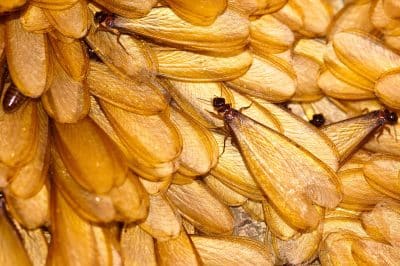Subterranean termites are social insects that live in large colonies made up of three statuses: the reproductives (a.k.a. swarmers), the soldiers and the workers.
The Swarmers
The swarmers are most often seen by homeowners and are often confused with winged ants. They have a pair of long, equally-sized wings attached to the last two thoracic segments, and the wings break off after they swarm to a new location. The abdomen of these swarmers is broadly joined to the thorax. This is different than the narrow “pinched” attachment found on ants. The “winged” reproductive class of the subterranean termites are almost always dark brown, sometimes varying in color to black with brownish grey wings.
The Soldiers
The soldiers have white bodies with yellow-brown heads and are responsible for defending the colony. They are generally 3/8 of an inch in length and have wings with a few hairs and two dark veins on the leading edges. Termite soldiers have rectangular heads measuring two times the length of their width and have large mandibles, which lack teeth.
The Workers
Worker termites are the most numerous in a colony. They are white in color, blind because they do not have eyes and are responsible for building and maintaining the colony through foraging and building tunnels. Homeowners and business owners that see termites are likely seeing either a swarmer or a worker.
Where do termites live?
Subterranean termites require contact with soil, which provides optimal temperatures and moisture for their survival. Subterranean termites build underground nests connected to above ground food sources via mud tunnels. These underground pests are responsible for the majority of termite damage to homes and buildings in the U.S. The swarms begin to move when the weather starts warming up, and they quickly make themselves at home in structures that do not have regular pest treatments, have cracks or holes in the foundation and around doors or windows.
Common Signs of Subterranean Termites
- Look for wood damage such as softened wood or areas that look “eaten out.”
- Mud tubes are a great indicator of termites. These pests use mud tubes to travel back and forth between the soil and the structure.
How to Eliminate and Prevent Subterranean Termites
If termites are suspected, it’s important to call a trained, experienced and licensed termite inspector to the property as soon as possible. United Pest and Turf Control has been inspecting and treating termite damage for more than 30 years. Contact us for a free estimate and to schedule a termite inspection. Our team uses the scientifically-proven Sentricon system to help prevent termites from entering a structure and causing damage. A few tips to help reduce the likelihood of termites include:
- Remove scrap wood, firewood and any other wood materials that are in contact with the soil and near the home or building.
- Fix any water leaks that create moist wood conditions. Wood with a moisture content of 15 percent or higher needs addressed immediately.
- Drainage systems installed around a structure should be designed so there is no water accumulation of water near the foundation. Poor exterior soil grades, planter boxes, sprinkler systems, air conditioner condensate drains, lack of gutters or gutter downspouts can create moist areas that are inviting to termites.
- Any infested wood should be removed and replaced immediately with treated wood. This is no guarantee that termites will not gain access to wood within a structure, but it is an additional control measure that is part of a comprehensive control program.
Fun Subterranean Termite Facts
- The mature Queen produces 5,000 to 10,000 eggs per year.
- An average termite colony consists of 60,000 to 250,000 individuals; however, there have been colonies numbering in the millions. Within the colony, more than 90 percent of the termites are workers.
- There is often more than one Queen termite, and she can live up to 30 years; workers live as long as five years.
- Subterranean termite colonies are established by the activity of the winged reproductive swarmers. This happens in the spring when the weather starts to turn warm.
What are Subterranean Termites in North Alabama and Southern Tennessee?
Serving North Central Alabama and South Central Tennessee
Limestone County
Ardmore
Home » What are Subterranean Termites?


